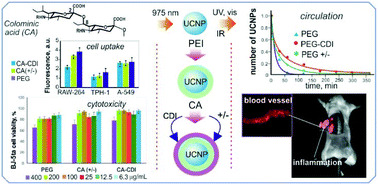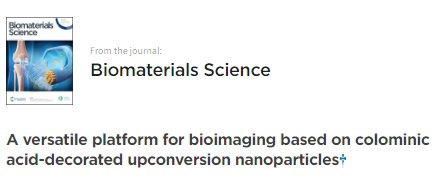Press-room / news / Science news /
A versatile platform for bioimaging based on colominic acid-decorated upconversion nanoparticles
Scientists from the IBCh RAS, Federal Scientific Research Centre “Crystallography and Photonics”, FSBSI “N.N. Blokhin Russian Cancer Research Center”, Lomonosov Moscow State University of Fine Chemical Technologies and Sechenov First Moscow State Medical University developed a method for the UCNP surface functionalization with endogenous colominic acid conferring “stealth” properties, which led to effective accumulation in the area of inflammation, as well as micro- and macro-blood vessels visualization.
Lanthanide-doped upconversion nanoparticles (UCNPs) are promising bioimaging agents that emit light under near infra-red excitation, capable of deep penetrating in biotissue with a high signal-to-noise ratio. However, their successful implementation is principally associated with surface functionalization with polymers.

Figure 1. Scheme of two-stage UCNP modification with colominic acid; UCNP-colominic acid nanocomplexes show low cytotoxicity in relation to BJ-5ta fibroblasts and low uptake by macrophages in vitro. The prolonged circulation time in the bloodstream as compared to PEG ensures efficient accumulation in the inflammation site and visualization of blood vessels
Colominic acid is a natural highly hydrophilic homopolymer of α-2,8-linked 5-N-acetylneuraminic acid, which does not cause toxic and immune responses and can be biodegraded under the action of neuraminidase to non-toxic sialic acid. The UCNP surface functionalization was proposed on the basis of a two-step strategy, consisting of the preliminary surface hydrophilization with polyethyleneimine followed by colominic acid modifiation in two ways - due to electrostatic interactions or due to the formation of a covalent bond.
Further studies have shown that, regardless of the modification method, colominic acid manifests itself as a non-toxic UCNP coating, which reduces the nonspecific blood proteins adsorption. Such nanocomplexes exhibit low uptake by RAW 264.7 macrophages, TPH-1 monocytes and A-549 human lung adenocarcinoma cells in vitro. Incubation for 24 hours with the BJ-5ta fibroblast cell line revealed a high level of cell viability. Chronic cytotoxicity (72-incubation with BJ-5ta) practically did not appear. In addition, the colominic acid implementation as a surface coating led to the circulation time elongation (up to 3 hours in the small animal bloodstream after intravenous administration) in comparison with polyethylene glycol.
Colominic acid surface modification opens the possibility of pathological tissue visualization, for example, inflammation, which is characterized by abnormal architecture of the vascular system. This phenomenon enables UCNP-colominic acid accumulation in inflammation site exploiting mechanism similar to an enhanced permeability and retention effect proper to solid tumors. In addition, nanocrystals modified with colominic acid can be successfully used for biovisualization of large and small vessels in acute inflammation that is important to study the distribution of nanodrugs in the composition of UCNP nanocomplexes. Thus, UCNP-colominic acid nanocomplexes have great potential for bioimaging, drug and photosensitizers delivery to the inflammation site.
The proposed approach of surface functionalization with colominic acid can be implemented to various nanoparticles, such as quantum dots, magnetic and plasmonic nanoparticles, etc. for their utilization in in vivo bioimaging.
The research was carried out with the financial support of the Russian Foundation for Basic Research No. 18-29-01021 and the Russian Science Foundation No.18-79-10198 and published in the journal Biomaterials Science.
september 3, 2020




